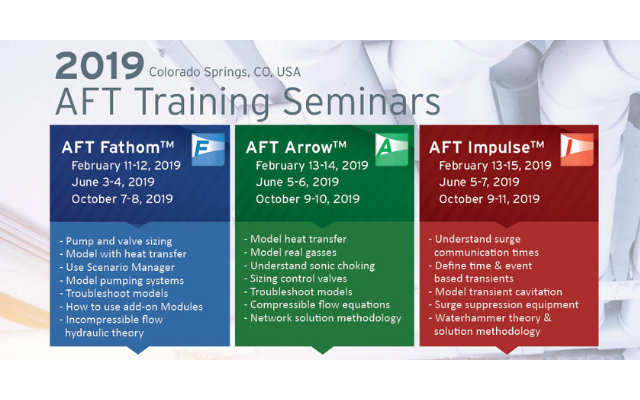Author: Ben Keiser, Applied Flow Technology Technical Sales Consultant
We hope you enjoyed our previous article on the Top 6 Reasons Your Design Should Include Flow Analysis, now let’s talk about three main reasons why flow analysis is neglected during the design process. It could be straight neglect or unconscious neglect. Either way, we will open the conversation and provide some insight taken directly from feedback we have received from hundreds of happy Applied Flow Technology (AFT) customers around the world.
You might be familiar with one or two of these points. Some may be in your control and others might be outside of your reach. Regardless, we hope that if you do find yourself within one of these realms – you will contact AFT to see how we can help you navigate within a software evaluation and show you how to easily overcome any of the below points.
Let’s get started.
Cost
A primary goal for end users (i.e., owner/operators) is for the project to come in under budget. Quality is of high importance of course, but there is usually not much room for a detailed analysis since it adds cost to the project.
If an engineering design company went the extra mile to determine a more optimal piping system configuration, they could potentially save end users millions of dollars in operating costs. This, however, may require a costlier system to be built up front and may not fit the budget either.
Therefore, end users may not require (or even ask) engineering companies to do a flow analysis due to the added cost, nor would an engineering company suggest doing it for the same reasons.
Lack of End User Education for Flow Analysis Value
End users are busy trying to keep the plant operating day to day. While some end users do understand flow analysis benefits, they do not have the time to build a model from scratch themselves. Other end users simply operate based on the operators’ experience of how the system should function.
Operations are often guided by simple observation of the system and making various adjustments to reduce noise or vibration, but there is not much scientific understanding as to why changing the operation in certain ways reduces noise or vibration among other issues.
A flow model easily shows why the system operates in a certain way. End users would better understand how the system interacts with itself. However, until end users see a flow model that clearly demonstrates issues and how to solve them, it can be a challenge to overcome the objection of the experienced operator simply knowing where the “sweet spot” is.
Educating end users on the benefits of flow analysis is of key importance. Demonstration of case studies is critical to show how flow models have helped other end users solve problems such as multiple repairs due to pump system issues like cavitation or the damaging effects of operating away from a pump’s best efficiency point.
Piping System Codes & Standards Do Not Require Flow Analysis
Piping codes and standards typically do not require the designer to conduct a flow analysis. If not required by the end user, the engineering company is free to choose if they do a flow analysis and they have liberty to choose how they do it: software, spreadsheets, or even simple hand calculations based on rules of thumb. Since piping system codes and standards were developed well before sophisticated flow analysis software existed, they simply do not address or provide much guidance on how to handle complicated piping networks.
Safety factors are added by the designer, and then project manager. Most likely the equipment vendor will add some, and the client might do the same. Now you have a significantly over-sized system with reliability issues, significant amounts of wasted energy and high operating costs.
A major downside is that systems are often significantly oversized. As the designer completes their work, they add a safety factor to account for unknowns. This is important to do since the “as built” system tends to deviate from the original design. Compounding the issue is the project manager adds his own safety factor upon review, the equipment manufacturers add their safety factors, and the client might do the same. The system is now significantly over-designed, so throttling valves are used to deliver the required flows. A large amount of energy is wasted, operating costs are incredibly high, and reliability issues will arise.
Do any of these points ring a bell? As engineers we have all been in the routine, under deadlines, and under expectations to improve reliability and safety while lowering energy waste and costs.
That is why Applied Flow Technology software exists – to give engineers the tools to succeed. Since advanced technology is readily available, it is our responsibility to learn how we can do a better job designing systems with powerful tools like these.
Fortunately, AFT can show you the costs, if you are violating any design requirements, codes and standards, and we have a plethora of data to support how it can help engineers in any industry go from guessing where “sweet spots” are to being on target each time.
When you work with AFT software for incompressible flow, compressible flow, and waterhammer/surge analysis, you will always be within your recommended operating ranges and will be able to design a safer, efficient and more reliable system.
This article is the second article in a 3-part series. Now that we have given you the Top 6 Reasons Your Design Should Include Flow Analysis and talked about Why Flow Analysis is Neglected, in the next article, we will discuss Why Flow Analysis is Necessary.
If you have any feedback for us on this or any of our articles, please feel free to contact us at info@aft.com.






Comments